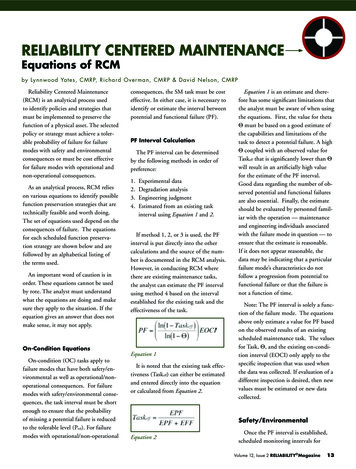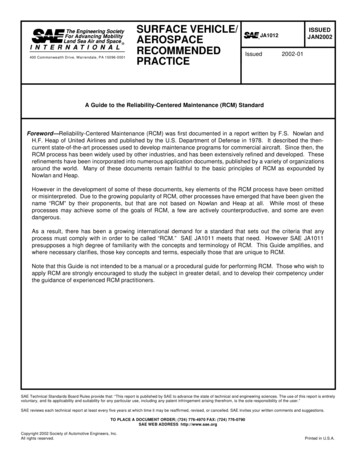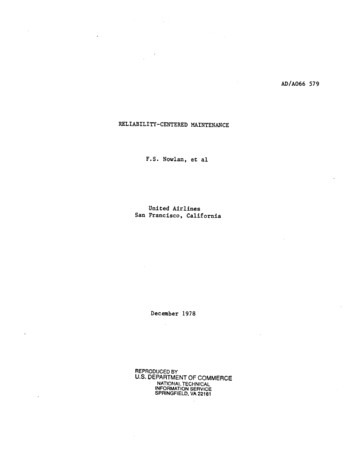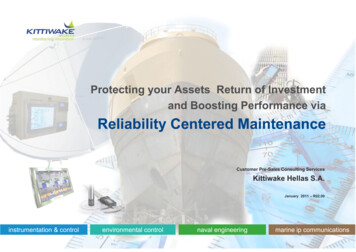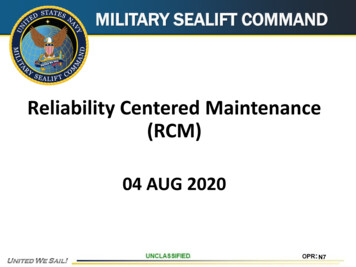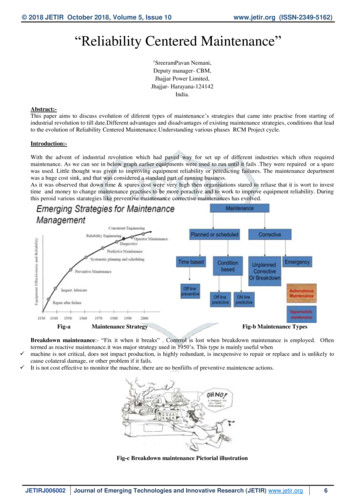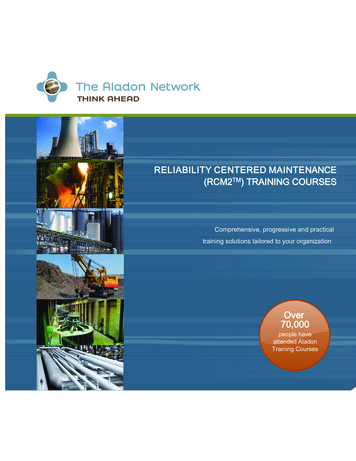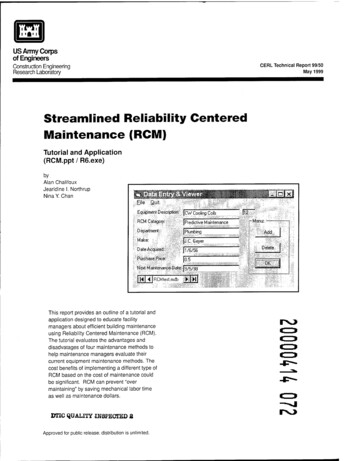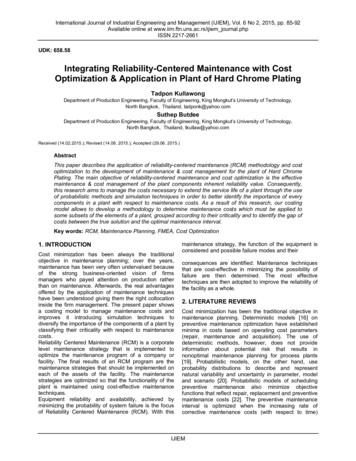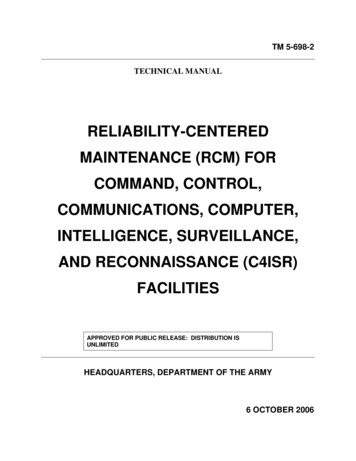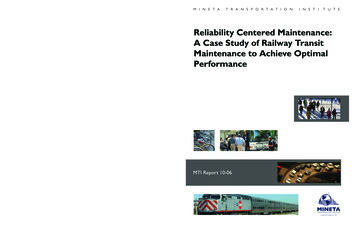
Transcription
MTIA Case Study of Railway Transit Maintenance to Achieve Optimal PerformanceFunded by U.S. Department ofTransportation and CaliforniaDepartment of TransportationReliability Centered Maintenance:A Case Study of Railway TransitMaintenance to Achieve OptimalPerformanceMTI Report 10-06MTI Report 10-06October 2010
MINETA TRANSPORTATION INSTITUTEMTI FOUNDERHon. Norman Y. MinetaThe Norman Y. Mineta International Institute for Surface Transportation Policy Studies (MTI) was established by Congress as partof the Intermodal Surface Transportation Efficiency Act of 1991. Reauthorized in 1998, MTI was selected by the U.S. Departmentof Transportation through a competitive process in 2002 as a national “Center of Excellence.” The Institute is funded by Congress through the United States Department of Transportation’s Research and Innovative Technology Administration, the California Legislature through the Department of Transportation (Caltrans), and by private grants and donations.The Institute receives oversight from an internationally respected Board of Trustees whose members represent all major surfacetransportation modes. MTI’s focus on policy and management resulted from a Board assessment of the industry’s unmet needsand led directly to the choice of the San José State University College of Business as the Institute’s home. The Board providespolicy direction, assists with needs assessment, and connects the Institute and its programs with the international transportationcommunity.MTI’s transportation policy work is centered on three primary responsibilities:ResearchMTI works to provide policy-oriented research for all levels ofgovernment and the private sector to foster the developmentof optimum surface transportation systems. Research areasinclude: transportation security; planning and policy development; interrelationships among transportation, land use, and theenvironment; transportation finance; and collaborative labormanagement relations. Certified Research Associates conductthe research. Certification requires an advanced degree, generally a Ph.D., a record of academic publications, and professionalreferences. Research projects culminate in a peer-reviewedpublication, available both in hardcopy and on TransWeb, theMTI website (http://transweb.sjsu.edu).EducationThe educational goal of the Institute is to provide graduate-leveleducation to students seeking a career in the development andoperation of surface transportation programs. MTI, through SanJosé State University, offers an AACSB-accredited Master of Science in Transportation Management and a graduate Certificatein Transportation Management that serve to prepare the nation’stransportation managers for the 21st century. The master’s degree is the highest conferred by the California State Universitysystem. With the active assistance of the California Departmentof Transportation, MTI delivers its classes over a state-ofthe-art videoconference network throughout the stateof California and via webcasting beyond, allowing workingtransportation professionals to pursue an advanced degreeregardless of their location. To meet the needs of employers seeking a diverse workforce, MTI’s education programpromotes enrollment to under-represented groups.Information and Technology TransferMTI promotes the availability of completed research toprofessional organizations and journals and works tointegrate the research findings into the graduate educationprogram. In addition to publishing the studies, the Institutealso sponsors symposia to disseminate research results totransportation professionals and encourages Research Associates to present their findings at conferences. The Worldin Motion, MTI’s quarterly newsletter, covers innovationin the Institute’s research and education programs. MTI’sextensive collection of transportation-related publicationsis integrated into San José State University’s world-classMartin Luther King, Jr. Library.MTI BOARD OF TRUSTEESHonorary Co-ChairHon. James Oberstar **ChairHouse Transportation andInfrastructure CommitteeHouse of RepresentativesWashington, DCHonorary Co-ChairHon. John L. Mica**Ranking MemberHouse Transportation andInfrastructure CommitteeHouse of RepresentativesWashington, DCDavid L.Turney*Chair/President/CEODigital Recorders, Inc.Dallas, TXWilliam W. MillarRebecca BrewsterSteve HemingerStephanie PinsonPresident/COOAmerican TransportationResearch InstituteSmyrna, GAExecutive DirectorMetropolitan TransportationCommissionOakland, CAPresident/COOGilbert Tweed Associates, Inc.New York, NYDonald H. CamphPresidentCalifornia Institute forTechnology ExchangeLos Angeles, CAAnne P. CanbyPresidentSurface TransportationPolicy ProjectWashington, DCVice Chair/PresidentAmerican Public TransportationAssociation (APTA)Washington, DC#Executive DirectorMineta Transportation InstituteSan Jose, CAPresidentDMJM HarrisWill KemptonNew York, NYPresident/CEOGranite Construction, Inc.Watsonville, CAChairmanPB Consult Inc.Washington, DCNuria FernandezRonald BarnesGeneral ManagerVeolia Transportation/EastValley RPTAJoseph BoardmanJane ChmielinskiMortimer DowneyHon. Rod Diridon, Sr.Executive DirectorAmerican Association of StateHighway & TransportationOfficials (AASHTO)Washington, DCPresident/CEOAmtrak60 Massachusetts Ave., N.E.Washington, DC 20002William Dorey Hans RatHon. John Horsley #CommissionerCity of Chicago,Department of Aviation,DirectorCalifornia Department ofTransportationSacramento, CABrian MacleodSenior Vice PresidentGillig CorporationHayward, CADr. Bruce MagidDeanCollege of BusinessSan José State UniversitySan José, CAExecutive DirectorGeneral ManagerTri-State Transit AuthorityHuntington, WVPaul Toliver #PresidentNew Age IndustriesSeattle, WAMichael S.Townes #President/CEOTransportation DistrictCommission of Hampton RoadsHampton, VAEdward WytkindPresidentTransportation TradesDepartment, AFL-CIOWashington, DC* #Mesa, AZHon. Rod Diridon, Sr.Vickie Shaffer**Chicago, ILDirectorsSecretary GeneralUnion Internationale desTransports PublicsBruxelles, BelgiumHonoraryChairVice ChairPast ChairResearch Associates Policy Oversight CommitteeAsha Weinstein Agrawal, Ph.D.Frances Edwards, Ph.D.Urban and Regional PlanningSan José State UniversityPolitical ScienceSan José State UniversityResearch DirectorJan Botha, Ph.D.Taeho Park, Ph.D.Peter Haas, Ph.D.Civil & Environmental EngineeringSan José State UniversityOrganization and ManagementSan José State UniversityKatherine Kao Cushing, Ph.D.Diana WuKaren E. Philbrick, Ph.D.Education DirectorDISCLAIMERDonna MaurilloThe contents of this report reflect the views of the authors, who are responsible for the facts and accuracy of the information presented herein. This document is disseminated under the sponsorship of the U.S. Department of Transportation, University Transportation Centers Programand the California Department of Transportation, in the interest of information exchange. This report does not necessarily reflect the officialviews or policies of the U.S. government, State of California, or the Mineta Transportation Institute, who assume no liability for the contents oruse thereof. This report does not constitute a standard specification, design standard, or regulation. The views and conclusions contained in thisdocument are those of the authors and should not be interpreted as necessarily representing the official policies, either expressed or implied,of the U.S. Department of Homeland Security.Communications DirectorEnviromental ScienceSan José State UniversityBrian Michael JenkinsDave Czerwinski, Ph.D.National Transportation Security Center ofExcellenceMarketing and Decision ScienceSan José State UniversityAsha Weinstein Agrawal, Ph.D.National Transportation Finance CenterMartin Luther King, Jr. LibrarySan José State University
MTI Report 10-06RELIABILITY CENTERED MAINTENANCE:A CASE STUDY OF RAILWAY TRANSITMAINTENANCE TO ACHIEVE OPTIMALPERFORMANCEFelix A. Marten, Jr., DBADecember 2010a publication of theMineta Transportation InstituteCollege of BusinessSan José State UniversitySan José, CA 95192-0219Created by Congress in 1991
Technical Report Documentation Page1.Report No.4.Title and Subtitle7.9.CA-MTI-10-29132.Government Accession No.Reliability Centered Maintenance: A Case Study of Railway TransitMaintenance to Achieve Optimal PerformanceAuthorsFelix A. Marten, Jr. , D.B.A.Recipients Catalog No.5.Report Date6.Performing Organization Code8.Performing Organization Report No.December 2010MTI Report 10-06Performing Organization Name and AddressMineta Transportation InstituteCollege of BusinessSan José State UniversitySan José, CA 95192-021910. Work Unit No.11. Contract or Grant No.DTRT 07-G-005412. Sponsoring Agency Name and AddressCalifornia Department ofTransportationSacramento, CA 94273-00013.U.S. Department of TransportationResearch and InnovativeTechnology Administration (RITA)1200 New Jersey Avenue, SEWashington, DC 2059013. Type of Report and Period CoveredFinal Report14. Sponsoring Agency Code15. Supplementary Notes16. AbstractThe purpose of this qualitative case study was to identify the types of obstacles and patterns experienced by a singleheavy rail transit agency located in North America that embedded a Reliability Centered Maintenance (RCM) Process. Theoutcome of the RCM process also examined the impact of RCM on availability, reliability, and safety of rolling stock. Thisqualitative study interviewed managers (10 cases), and non-managers (10 cases) at the transit agency obtain data. Thedata may serve to help rail transit leaders determine future strategic directions that would improve this industry. Despite theRCM record in other fields, it has infrequently been used in heavy rail transit agencies. The research method for the firstportion of this qualitative case study was to collect data from subjects by administering an open-ended, in-depth personalinterview, of manager and non-managers. The second portion of the study explored how the RCM process affected rollingstock for availability, reliability, and safety. The second portion of the study used data derived from project documents andreports (such as progress reports, email, and other forms of documentation) to answer questions about the phenomena.The exploration and identification of the patterns and obstacles is important because organizational leaders in other heavyrail transit systems may use this knowledge to assist in embedding the process more smoothly, efficiently, and effectively toobtain the desired end results.17. Key WordsImplementation; Infrastructurepreservation; Operation andmaintenance; Operational issues;Passenger rail services18. Distribution Statement19. Security Classif. (of this report)20. Security Classifi. (ofthis page)UnclassifiedNo restrictions. This document is available to the public throughThe National Technical Information Service, Springfield, VA 22161UnclassifiedForm DOT F 1700.7 (8-72)21. No. ofPages10422. Price 15.00
Copyright 2010by Mineta Transportation InstituteAll rights reservedLibrary of Congress Number 2010938046To order this publication, please contact the following:Mineta Transportation InstituteCollege of BusinessSan José State UniversitySan José, CA 95192-0219Tel (408) 924-7560Fax (408) 924-7565email: mti@mti.sjsu.eduhttp://transweb.sjsu.edu
AcknowledgmentsThe authors would like to acknowledge and thank the following people for their importantcontributions to this project. Thank yous are in order to Dr. Martin Gunnell, Dr. FrankKahren, and Dr. Brent Hardegree.The authors also thank MTI staff, including Research Director Karen Philbrick, Ph.D.;Director of Communications and Special Projects Donna Maurillo; Research SupportManager Meg A. Fitts; Student Publications Assistant Sahil Rahimi; Student ResearchSupport Assistant Joey Mercado; Student Graphic Artists JP Flores and Vince Alindogan;and Webmaster Frances Cherman. Additional editorial and publication support wasprovided by Editorial Associate Catherine Frazier.
iTable of ContentsExecutive Summary 1INTRODUCTION 3Background of the Problem Statement of the Problem Purpose of the Study Significance of the Study to Leadership Nature of the Study Research Questions Conceptual Framework Definition of Terms Assumptions Limitations Delimitations Summary REVIEW OF THE LITERATURE Urban Transportation in North America Public Transportation Ridership Trends Deterioration Due to a Lack of Maintenance Maintenance as a Form of Strategy Reliability Centered Maintenance Implementation Obstacles Change Management Conclusion Summary METHODOLOGY 3677899101112121215171825263133353639Research Design Methodology Justification Population Sampling Informed and Organization Consent Confidentiality Geographic Location Data Collection The Data Collection Process Instrumentation Pilot Study Validity Min e ta Tra n s p o rt a t io n I n s t it u t e394444444545464647484949
Table of ContentsiiData Analysis Summary 5151PRESENTATION AND ANALYSIS OF DATA Research Questions Sample Pilot Study Data Collection Process Data Analysis Results and Findings Summary CONCLUSIONS AND RECOMMENDATIOnS Overview Significance to Leadership Findings and Interpretations Implications Recommendations Summary and Conclusion 535354545556586567686869747575APPENDIX A: MILESTONES IN U.S. PUBLIC TRANSPORTATION HISTORY 77AppenDix B: Transit Agencies in North America 79APPENDIX C: INDIVIDUAL INFORMED CONSENT FORM 83APPENDIX D: ORGANIZATION CONSENT AND CONFIDENTIALITY Form 85APPENDIX E: NON-MANAGEMENT INTERVIEW SCHEDULE 89REFERENCES 91Abbreviations and Acronyms 99About the Author 101Peer review 103Min e ta Tra n s p o rt a t io n I n s t it u t e
iiiList of FigureS1. Billions of Passenger Trips in the United States from 1900 to PresentMin e ta Tra n s p o rt a t io n I n s t it u t e19
ivList of FiguresMin e ta Tra n s p o rt a t io n I n s t it u t e
vList of Tables1. Demographic Characteristics592. Problems with the Predicted Implementation Time603. Effective Communication Methods Used614. Influence of Organizational Culture on RCM Implementation615. Effect of RCM Process on Employees626. Most Challenging Aspects of Implementing RCM627. Biggest Obstacles of Implementing RCM648. Impact of RCM on Rolling Stock64Min e ta Tra n s p o rt a t io n I n s t it u t e
viList of TablesMin e ta Tra n s p o rt a t io n I n s t it u t e
1Executive SummaryThis qualitative case study identified the types of obstacles and patterns experienced bya single heavy rail transit agency located in North America that embedded a ReliabilityCentered Maintenance (RCM) process. The outcome of the RCM process also examinedthe impact of RCM on availability, reliability, and safety of rolling stock. This qualitativestudy interviewed managers (10 cases), and non-managers (10 cases) at the transitagency to obtain data. The data may serve to help rail transit leaders determine futurestrategic directions that would improve the heavy rail transit industry. Despite the RCMrecord in other fields, it has infrequently been used in heavy rail transit agencies.The research method for the first portion of this qualitative case study was to collect datafrom subjects by administering an open-ended, in-depth personal interview, of managersand non-managers. The second portion of the study explored how the RCM processaffected rolling stock availability, reliability, and safety.The study used data derived from project documents and reports (such as progress reports,email, and other forms of documentation) to answer questions about the phenomena.The exploration and identification of the patterns and obstacles are important becauseorganizational leaders in other heavy rail transit systems may use this knowledge to assistin embedding the process more smoothly, efficiently, and effectively to obtain the desiredend results.Based on the analysis of data, seven themes emerged in regard to obstacles experiencedby maintenance employees during the implementation of the RCM process at the singleheavy rail transit agency. The first theme related to the problems with the predictedimplementation time. The second theme was the effective communication methods used.The third theme was the influence of organizational culture on RCM implementation. Thefourth theme was the effect of RCM processes on employees. The fifth theme was themost challenging aspects of implementing RCM. The sixth theme was the most significantobstacles of implementing RCM. The seventh theme was the impact of RCM on rollingstock.The analysis revealed that there was very mixed results regarding the impact of RCM onthe rolling stock. Some of the participants indicated that there was an increase in safety andreliability, whereas others indicated that there was a decrease in those aspects. However,the analysis revealed that the participants indicated that there had been a significantincrease in rolling stock availability since pre-RCM.Min e ta Tra n s p o rt a t io n I n s t it u t e
2Executive SummaryMin e ta Tra n s p o rt a t io n I n s t it u t e
3INTRODUCTIONMultinational leaders, managers, and employees of heavy rail transit agencies have facednew challenges in the 21st century related to innovation, technology, quality assurancemovements, and downsizing initiatives (Newstrom and Davis 2002). One such innovationthat has made use of technology to drive quality management is Reliability-CenteredMaintenance (RCM) (Backlund and Akersten 2003; Campbell and Reyes-Picknell 2006;Hansson, Backlund, and Lycke 2002). RCM is a process that identifies the maintenancerequirements of physical assets (plant, rolling stock, and buildings) and productivity tocomplement the operational goals of the organization (Campbell and Reyes-Picknell).This ultimately results in optimal performance of the equipment as reported by Campbelland Reyes-Picknell.Campbell and Reyes-Picknell (2006) reported that RCM must progress through threeiterative steps before significant results are achieved. First, the RCM process mustexamine the function of the asset and understand the productivity goals of the asset.Second, various methods by which an asset can fail should be explored, including theimpact of failure on other systems and subsystems. Third, depending on what is learnedduring the previous steps, RCM develops mitigation strategies that can be implementedagainst potential failures. When the RCM process has been used in other industries, themaintenance process increased equipment efficiency, reliability, and safety, and loweredmaintenance costs (Backlund and Akersten 2003; Delzell and Pithan 1996; Fleming 2006;Toomey 2006). Creecy (2003) reported that some organizations have realized up to 147million per year in RCM-related maintenance cost savings.Despite the RCM record in other fields, it has infrequently been used in heavy rail transitagencies. The focus of this qualitative case study was to interview 20 employees—onegroup in management (10 cases), and the other in non-management positions (10 cases)—of an East Coast United States heavy rail transit agency who have had at least one yearof work experience with an RCM maintenance system to identify types of obstacles andpatterns experienced embedding an RCM maintenance program. The outcome of the RCMprocess also sought to identify the impact on maintenance of the rolling stock (known as therevenue vehicles carrying passengers or a train) with regard to availability, reliability, andsafety. This data may serve to help rail transit leaders determine future strategic directionsthat would improve this industry.This chapter includes an overview of the case study, the general and specific problemstudied, the purpose statement, the significance of the study, the significance of the study toleadership, the nature of the study, the research questions, and the conceptual frameworkthat guided the case study. It also includes definitions of key terms, assumptions, limitations,delimitations, and a section summary. The summary recaps significant points of the studyregarding the implementing of an RCM process in a heavy railway transit agency.Background of the ProblemAccording to the American Public Transportation Association (APTA) (2007), heavy railtransit agencies in 2005 spent more than 5.2 billion dollars on maintaining rolling stock,Min e ta Tra n s p o rt a t io n I n s t it u t e
4Introductionwhich represents a substantial amount of their operating budget. Heavy rail transit agenciesdepend on their fleet of rolling stock to move their patrons from point-A to point-B. Thelack of a properly maintained fleet could create service problems that result in a changein leadership at the affected agency. A sustainable inability to provide transit servicecould even force the agency to seek bankruptcy protection. In order for heavy rail transitagencies to sustain their existence, transit leaders, may want to explore if an RCM-basedmaintenance process in a non-RCM-based maintenance organization is an option.The demand for public transportation in the 21st century is estimated to increase basedon a number of factors, including: (a) growing population, (b) increases in cost of fuel forpersonal vehicles, (c) increases in traffic congestion, (d) environmental concerns and thegreen revolution, (e) urban growth, and (f) increasing employment (APTA 2006; CapitalCorridor 2007; Celik and Yankaya 2006). These factors can influence decisions madeby a heavy rail transit board of directors. The government and the public both realizethe economic importance of rapid transit agencies (APTA). Rapid transit agencies areestablished to provide transportation services to the general public, and are governed bya board of directors.The board of directors of heavy rail transit agencies is accountable to several governingbodies, including county, state, and federal governments. The board of directors overseesthe operation of the transit agency, and their stakeholders and constituencies hold themaccountable for their business decisions. According to Capital Corridor (2007), thegovernment supports mass transit, primarily because it offers an efficient carbon footprintover personal vehicles, thus reducing the amount of global warming gases emitted byindividual vehicles. Public transportation is supported because heavy rail transit systemsare more efficient to operate and cost less per passenger mile than traveling by personalvehicle (Capital Corridor 2007).Compared to the initial stagecoach transit system, heavy rail transit systems of the 21stcentury are considerably more complex, efficient, and effective (Middleton 2006). Theseinnovations are attributed to the advances in complex solid-state technology and theInformation Age (Wolinsky 2006). Middleton (2006) noted that the more sophisticatedand complex the transit vehicles (also known as rolling stock) design becomes, the moremaintenance the rolling stock requires to remain efficient and reliable.Increased rolling stock complexity increases the likelihood that failures will be experienced;frequent maintenance inspections are deemed necessary to avoid recurrent failures(Hansson et al. 2002; Tsang 2002). Non-operational rolling stock is difficult to removefrom service because of the disruption to schedule when it fails on mainline (Lustig 2005).Mainline failures cause system-wide delays and customer dissatisfaction with the transitagency (BART 2006a). The goal of the maintenance department is to eliminate or correctany known problem on the rolling stock, (e.g., brake problem, propulsion, or HVAC) orany mechanical failure that would keep the train from moving on its own propulsion.Rolling stock absent of any mechanical or electrical failures are considered revenue readyvehicles (operational rolling stock) ready for revenue service.Heavy rail transit agencies are heavily invested in rolling stock, which consists of heavy,Min e ta Tra n s p o rt a t io n I n s t it u t e
Introduction5complex, and expensive machinery. Due to the nature of such machinery, agencies needto consider various methods of maintenance. Backlund and Akersten (2003) documentedthat organizations that had implemented an RCM-based maintenance process realized anincrease in rolling stock availability, reliability, and safety.RCM PrinciplesMoubray (as cited in Mostafa 2004) defined RCM “as a process used to determine themaintenance requirements of any physical asset in its operating context, and [to] determinewhat must be done to ensure that the equipment continues to fulfill its function” (109).Backlund and Akersten (2003) noted that the RCM process combined several well-knownrisk analysis tools and techniques, including failure modes and effect analysis, as well asdecision-tree analysis to identify problematic areas. Wheeler (2007) stated that the RCMprocess is more than just a way of performing maintenance. Wheeler noted “in a nut shell,it’s a way at looking at system performance in terms of the impact of a failure and thenmitigating those results by design, detection, or effective maintenance” (38).According to Backlund and Akersten (2003), different terms have been used in the literatureto refer to RCM-based maintenance. Researchers have used the terms RCM process,RCM technique, and RCM method interchangeably. According to Backlund and Akersten(2003), RCM is a process to maintain or improve reliability, availability, and safety, as wellas control the cost of maintenance by reducing the amount of maintenance required.Tsang (2002) reported that maintenance plays a vital role in any organization usingmachinery and should be incorporated into an organizations’ business model. Backlundand Akersten (2003) and Hansson et al. (2002) reported that for an efficient and successfulimplementation of the RCM process, organizations might need to review their currentbusiness processes.Several transit agency directors have challenged railway managers to seek alternativemethods to the existing maintenance processes to optimize rolling stock reliability, improveavailability, and reduce maintenance costs (BART 2006a). Managers of heavy rail transitagencies are looking for a method of optimizing the performance of maintenance programsand availability of rolling stock while reducing maintenance costs.One potential process that managers explored was RCM, in which RCM uses statisticalanalysis tools to optimize the performance of the equipment (Backlund and Akersten2003; Fleming 2006; Hanson and Backlund 2003; Pintelon et al. 1999; Schein, 2004).The absence of a published study regarding implementing an RCM process in heavyrail transit agency may be limiting understanding of how the process functions and whyit may be successfully applied to heavy rail transit agencies. Exploring the embedding ofthe RCM process and its outcome in one heavy rail transit agency may contribute to theadoption of an RCM process at other transit agencies. Adoption of an RCM process mayallow heavy rail transit agencies to optimize performance, increase reliability, availability,and improve the safety of the rolling stock at a reasonable economic cost (BART 2006a).Min e ta Tra n s p o rt a t io n I n s t it u t e
Introduction6Statement of the ProblemThe general problem that is addressed in this study relates to a number of failures (rangingfrom a quantity of 5, and as many as 15 or more) of rolling stock that are experiencedby heavy rail transit and the organizational need to cope with them (BART 2006a). Forexample, San Francisco Bay Area Rapid Transit (BART) reported that heavy rail transitagencies experience frequent and long service delays almost daily. These delays areoften greater than 5 minutes and frequently occur during peak revenue hours. Sincethe inception of rolling stock, leaders in the heavy rail transit industry have operated therolling stock until it failed.Operational failures not only impact the customers’ satisfaction level and increasemaintenance cost (BART 2006a; Forker, Vickery, and Droge 1996), but also deter patronsfrom relying on public transportation (Murthy, Atrens, and Eccleston 2002). According toBART, a decrease in ridership results in a loss of fare-box revenue, which is essentialfor maintaining and operating an urban railway transit system. A cycle of rolling stockmaintenance failures due to poor maintenance practices leads to a loss of revenue forthe transit agency.The specific problem is the lack of sufficient knowledge about the obstacles and patternsexperienced by heavy rail transit agencies when implementing an RCM process and theoutcome of RCM with regard to rolling stock availability, reliability and safety.One specific way of coping with rolling stock failures can be through the advantagesoffered by an RCM process. A lack of knowledge makes it more challenging for leadersof heavy rail transit agencies to address the barriers to a smooth transition implementingthe RCM process. The gap in the literature regarding traditional challenges highlights theneed for studies that examine RCM transitional experiences. The result of this study mayinfluence leaders on strategies that would contribute to minimizing or avoiding potentialobstacles (including lack of management support and understanding, lack of training,partial implementation, and well-defined goals) experienced by other heavy rail transitagencies during the RCM embedding process. Transit agencies struggle to keep theirrolling stock revenue ready, they can minimize and avoid potential obstacles by seekingto locate maintenance strategies that can optimize rolling stock performance.The focus of this qualitative case study was to interview 20 employees—one group inmanagement (10 cases), and the other in non-management positions (10 cases)—of anEast Coast United States rail transit agency who have at least one year of work experiencewith the use and implementation of an RCM-based program. QSR-NVivo 8 software wasused to perform content analysis of interviews and project documentation (e.g., projec
RELIABILITY CENTERED MAINTENANCE: A CASE STUDY OF RAILWAY TRANSIT. MAINTENANCE TO ACHIEVE OPTIMAL PERFORMANCE . Felix A. Marten, Jr., DBA December 2010. a publication of the. Mineta Transportation Institute College of Business San José State Unive

